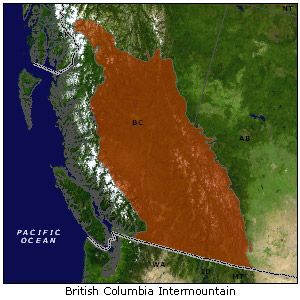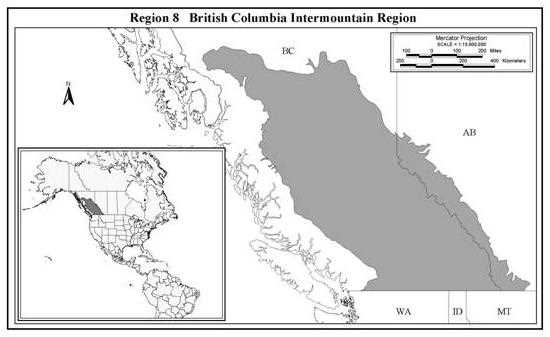Level III Ducks Unlimited conservation priority area, breeding grounds for more than 1.1 million waterfowl

The British Columbia Intermountain region covers more than 34 percent of the area of British Columbia, and supports a breeding waterfowl population of more than 1 million birds. The area includes the Canadian portion of the North American Bird Conservation Initiative (NABCI) Great Basin and the majority of the Canadian portion of the Northern Rockies Bird Conservation regions. The region is delineated by the crest of the Coast Mountains on the west, the crest of the Rocky Mountains on the east, the southern extent of the boreal forest to the north and the boundary with the United States on the south.


The Intermountain Ecological Region (Intermountain) of British Columbia (Region 8) includes the Canadian portion of the NABCI Great Basin and the majority of the Canadian portion of the Northern Rockies Bird Conservation Regions. It occupies approximately the southern half of the province. The region is delineated by the crest of the Coast Mountains on the west, the crest of the Rocky Mountains on the east, the southern extent of the boreal forest to the north, and the boundary with the United States on the south. The region covers 320,000 km2, over 34% of the area of BC, and supports a breeding waterfowl population of approximately 1.1 million birds. Four percent of this area (12,300 km2) is lakes and wetlands. The Intermountain contains 4 ecoprovinces, including 10 ecoregions and 37 ecosections. Elevation ranges from 200 meters to over 3,000 meters above sea level. Within the Intermountain, the habitats most important to waterfowl occur in the valleys and on mid-elevation plateaus.
Ninety-two percent of BC is publicly owned provincial Crown land with the remainder privately owned, First Nations reserves, or parks. The majority of wetland drainage has taken place on private land in valley bottoms where up to 80% of wetlands have been drained. While the few wetlands remaining on private land are highly productive, by far the majority of remaining waterfowl habitat exists on Crown land. Crown land is available to the public and its regulation is defined by public policy and legislation.
Importance to waterfowl
The Intermountain contains important breeding habitat for 26 species of ducks as well as Canada geese. Two conservative provincial estimates of breeding waterfowl populations suggest about 1.7 million ducks breed in BC or approximately 4% of the breeding waterfowl population in Canada. It is particularly important to Barrow's goldeneyes and provides breeding habitat for more than 60% of the world's population of this species. A recent effort to calculate the number of waterfowl breeding in the interior alone suggests 1.1 million ducks or 65% of the total provincial waterfowl population breed in the Intermountain. Density of breeding waterfowl in the Intermountain ranges as high as 36.3 pairs/km2 (94 pairs/mi2) in some locations.
Population data from 1967-69 and 1987-98 suggest that mallards, northern pintails, blue-winged teal, common goldeneyes, ruddy ducks, harlequin ducks, common mergansers, and red-breasted mergansers have markedly declined in abundance in BC during the last 30 years. More recent trend estimates also suggest that Barrow's goldeneyes and lesser scaup are declining throughout the Intermountain. Although it is unclear what factors may have contributed to these declines, it is likely that wetland loss and rangeland degradation have been key factors contributing to the decline of dabbling ducks. Intensified logging activities, and its accompanying negative effects on wetland and riverine habitats, have likely contributed to declines in several species of diving ducks.
In addition to providing important breeding habitat for waterfowl, the Intermountain is used extensively by migrating and wintering waterfowl. The strategic location of the Intermountain between significant breeding areas in Alaska and key wintering areas in California and western Mexico contribute to heavy use of this region by migrating waterfowl. Up to 8 million waterfowl comprised of 38 different species migrate through the interior of BC. Also, growing numbers of waterfowl winter on the rivers and large lakes in the Intermountain. Notably, more than 2,000 of the world's remaining 19,000 trumpeter swans currently winter in the Intermountain.
In addition to being important to waterfowl, the habitats in the Intermountain are valuable to other species as well. British Columbia is one of the most biologically diverse regions in North America and certainly the most biologically diverse province in Canada. Excluding marine fish, BC contains 732 species of vertebrates including 467 species of birds, 143 species of mammals, 19 species of reptiles, 20 species of amphibians, and 83 species of freshwater fish, many of which rely on habitats in the Intermountain. Nearly 300 species of birds breed in the province, 40 of which breed nowhere else in Canada. Furthermore, the province has 2,073 species of native plants of which nearly 20% are currently considered at risk. Most of the province's threatened and endangered wildlife and plants are found in the grassland districts of the southern Intermountain.
Although topography contributes to habitat diversity, we define 4 landscapes based on major land uses within the past 150 years, namely ranching, forestry, crop-based agriculture, and urbanization. These uses loosely define the following landscapes: Rangeland, Forestland, Agriculture/Forest Fringe, and Urban and Urban Fringe. Because land uses are not necessarily confined to specific areas, the defined landscapes overlap each other to varying degrees.
Rangeland includes 5 million ha of natural grasslands, open forests, and aspen parklands, as well as 250,000 ha of lakes and wetlands, making up 16% of the Intermountain. Lower elevation grasslands and open forests are generally privately owned while higher elevation grasslands and forested rangelands are Crown land. Rangeland wetlands are some of the more productive habitats in the Intermountain, supporting at least 300,000 breeding ducks. While breeding pair densities as high as 7 pairs/ha have been documented on individual wetlands, 2.5 pairs/ha is more typical of average waterfowl habitat. Over 100 years of unmanaged livestock grazing have depleted the vegetation in and around many wetlands, reducing nesting and brood-rearing cover. While range management practices have improved since the 1950s, degraded wetland and upland conditions continue to limit waterfowl productivity.
Forestland makes up 80% of the Intermountain, containing 1,000,000 ha of lakes and wetlands, and supporting approximately 800,000 breeding waterfowl. Although grazing occurs in part of the forestland, timber harvest and management practices affect the majority of the landscape. Impacts include altered water regimes with faster freshets, increased erosion and sedimentation, increased downstream nutrient loading, blowdown along cutblock edges and riparian areas, reduced beaver populations, loss of wildlife trees, and suppression of natural deciduous regrowth following logging. While loss of wildlife trees is obviously detrimental to cavity-nesting waterfowl, other alterations may have a more subtle effect on waterfowl populations and species. There are some private woodlots, but the majority of Forestland is publicly owned Crown land.
The Agriculture/Forest Fringe landscape is defined by the area currently in crop-based agriculture (hay, tame pasture, cereal grains), as well as the adjacent forest fringe into which it will expand in the future. While agriculture occurs in valley bottoms throughout the Intermountain, the projected area of expansion into the forest fringe is primarily focused in the Nechako Valley in the northern part of the region. Approximately 500,000 ha of Crown Forestland are suitable for crop production and approximately 7,500 ha are logged, drained and converted to privately owned agricultural land each year. The Agriculture/Forest Fringe landscape makes up only 4% of the Intermountain, but together with the urban landscape, contains the majority of drained wetlands. A minimum of 20,000 ha of wetlands has been drained to accommodate agriculture. Forty-five thousand ha of wetlands remain in this landscape, supporting approximately 70,000 breeding waterfowl. Given the high productivity of agricultural habitats, this drainage could have resulted in the loss of 140,000 breeding pairs.
The Urban and Urban Fringe landscape is made up of the populated urban areas together with the surrounding habitats into which expanding populations are expected to grow. The current Intermountain population of 900,000 people is expected to increase by 38% in the next 20 years. Towns have a history of draining, filling and building on wetlands as they grow. Present urban area covers 150,000 ha but nearly 9,000,000 ha of Agriculture/Forest Fringe, Rangeland and Forestland falls within 10 km of these areas and is particularly susceptible to impacts from urban expansion, hobby farms, and increased recreational activities. Over 400,000 ha of lakes and wetlands fall within the Urban and Urban Fringe landscape, supporting approximately 400,000 breeding waterfowl.
Waterfowl conservation programs began in earnest in the Intermountain in 1968, when at the invitation of the provincial government, Ducks Unlimited moved to BC and opened an office in Creston. Since then, DU has expanded activities throughout the Intermountain with key focus areas in the Kootenay and Columbia River valley's, the grasslands of the Thompson Okanagan River valleys, the vast Cariboo-Chilcotin plateaus and the Nechako River valley.
The primary emphasis in the Intermountain until the late 1980s was to provide adequate water for waterfowl breeding habitat to the arid wetland landscapes. This resulted in the construction of over 550 water control projects, in cooperation with other partners, covering more than 50,607 ha at a cost of approximately $30 million. A major shift in DU's approach to waterfowl conservation programs began in the late 1980s when funding partners were actively recruited to help deliver broader, landscape projects extending beyond water management to include uplands. In 1992, Ducks Unlimited and the Canadian Wildlife Service (CWS) embarked on the Interior Wetlands Program (IWP) to encourage new approaches to land use and management that would benefit waterfowl, other wildlife, fisheries resources and agriculture. The main objectives were to promote land use practices that would result in healthy wetland and upland vegetation for food, nesting and escape cover for waterfowl and other wildlife, maintained or improved water quality and quantity and sustainable agriculture. The six year, $4.2 million program delivered by DU secured 10,121 ha of high quality habitat and involved over 100 partners and cooperators who provided time, resources and expertise. Each of the 31 projects contained an extension component whereby information was shared with many other landowners to protect high quality habitat from incompatible use. Projects were evaluated to ensure that future waterfowl needs could be more accurately addressed.
The final report of the IWP was completed in 1998 and recommended that future programs would include the entire Intermountain, increase partnerships, expand extension activities, and continue program evaluation. Although the program created an awareness of the overall functioning of wetland landscapes, surveys indicated that the job had just begun. As a result, DU and CWS, together with other potential partners, developed the Intermountain Wetland Conservation Program (IWCP). The IWCP became a partnership of 12 organizations with a mission to maintain, enhance, restore or manage BS's intermountain wetland landscapes. Delivery of the IWCP will commence in the year 2000.
Ducks Unlimited uses cookies to enhance your browsing experience, optimize site functionality, analyze traffic, and deliver personalized advertising through third parties. By continuing to use this site, you agree to our use of cookies. View Privacy Policy